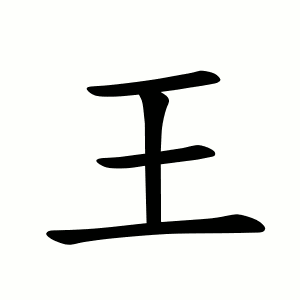王
- king, ruler, sovereign;
Etymology
王 is traditionally seen as a pictograph:
Early oracle bone script shows three main forms:
1. Shape identical to the modern 王.
2. Shape similar to 大 with an added horizontal stroke below.
3. Same as (2) but with yet another horizontal stroke above.
Interpretations:
Most scholars view it as the axe head, symbol of execution. In early societies where capital punishment symbolized ultimate authority, the axe represented the supreme power of the ruler.
Later, before oracle bones were discovered, thinkers (e.g., Han scholar Dong Zhongshu) explained it differently: the three horizontal strokes represent Heaven, Earth, and Humanity, united by a vertical stroke. Thus, “the king” is the one who links and governs these three realms. This explanation was recorded in the Shuowen Jiezi.
In the Zhou dynasty, 王 was used as the title of the supreme ruler.
From the Qin dynasty onward, the title 皇帝 (emperor) was created; 王 then came to denote subordinate rulers (vassal kings or princes), a rank below emperor.
The character also retained the sense of “great, excellent,” seen in expressions like 왕○○하다 (to be extremely …) in Korean.
Radical: originally its own radical, but later absorbed into 玉 (jade radical) because 玉 is graphically a derivative of 王.
Thus, when 王 appears as a radical, it usually stands for “jade.”
Usage in Korean
국왕 (國王) – king of a nation
왕자 (王子) – prince
여왕 (女王) – queen
왕조 (王朝) – dynasty
제왕 (帝王) – emperor, sovereign
왕국 (王國) – kingdom
